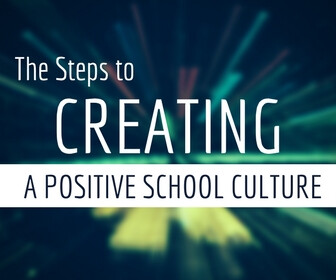Motivation, success, and feeling valued are what drives individuals, at any level and in any profession. In the school setting, it is critically important that we celebrate and recognize the outstanding things that our school community accomplishes, both inside and out of our buildings. Here are some of the main contributors to creating, building, or sustaining a positive school culture.
Invest in People, Build Relationships
Relationships are perhaps the most important part of establishing a school culture that is perceived as and breeds caring. When people feel valued, staff and students alike, they are likely to work harder, stay the course, and enjoy their work. When students feel liked and respected by their teachers, they find more success in school, academically and behaviorally (Lewis, Schaps & Watson, 1996). It should be the goal of all staff in a school to foster and forward positive relationships with students and among peers. This can become contagious, and can become the mantra of a school building; one which promotes and celebrates kindness among all.
I am a proponent of investment in people. The dividends to be had when a building becomes a place where people want to come to work, want to work hard, and transfer those feelings to students, is powerful beyond measure. “Programs are only as good as the paper they are written on without the people who implement them. A school culture doesn’t exist because of a program. It exists because of the people within the building. That includes aides, secretary, food service, teachers, administrators, parents and most importantly students (Whitaker, 2011).” A building (or classroom, or district) where this culture exists is a strong foundation for positive experiences and learning to take place.
Have a Shared Vision
Another component of creating or sustaining a positive school culture is having a consistent, shared vision for your school. School staff and students need to feel that they are being treated in the same manner as everyone else, regardless of their differences. Generating school and classroom rules, expectations, and having leadership that will follow through consistently with discipline and consequences can create a sense of trust and support; for staff to feel as though they are supported to do their jobs well, and trust among all school constituents that the rules are followed and enforced consistently.
Along these lines, consequences for bad choices should be developed with the input of school stakeholders, and should be fair relative to the offense. Being too firm, or the opposite, can elicit a lack of trust from students and parents. Aligning your discipline processes, procedures, and consequences to infractions in a fair and consistent manner can have the ability to serve its purpose while building character in students as they move forward after the incident. Balance, follow through, and consistency are key components to this process in order for it to have its greatest effect.
Be a Role Model, Set the Tone
As is best practice in instruction, modeling is key to understanding with anything in school buildings. Therefore, it is important to model these behaviors. School leadership and staff alike should lead by example. Students notice and can learn from our behaviors and the way we handle ourselves in daily situations. Be a role model! Show students how to be kind, caring, and that you value them. The return on that investment can be a group of students who are respectful of all; their teachers, school staff, and most importantly, each other.
Think about how you handle things and reflect on what the messaging of those choices have for students. Are you modeling the behaviors you want to see in students if put in a similar situation? You, as an educator and a role model, set the tone of your classroom and your school building by showing and modeling how you want your students to behave and react to situations on a daily basis. Showing kindness, caring, and acceptance are powerful and lasting characteristics for students to observe and ingrain.
Praise and Celebrate
What do leaders do when these things are happening? How do we sustain this or build on it? We need to praise appropriately and celebrate victories; large and small. Recognition is one way in which people feel valued. As a school leader or teacher, there are a variety of ways to do this. Hand-written notes, creating a certificate, a bulletin board, a phone call home, or a school or class newsletter are all avenues that can recognize students and/or staff and make them feel appreciated. Ignoring these things do nothing in terms of appreciating people, and can portray a lack of caring and respect. The power of praise in changing student behavior is that it both indicates teacher approval and informs the student about how the praised academic performance or behavior conforms to teacher/school expectations (Burnett, 2001). Supplying students with positive feedback and showing them that you care speaks to the first portion of this process, building relationships and the investment in people.
There are many contributors to creating a positive school culture and atmosphere. While these are certainly not exhaustive or all-inclusive, they can provide some practical ideas to institute or model in your school buildings. A positive school climate, many argue, is directly correlated to school success. When students feel safe, supported, respected, and valued in their environment, the foundation is set for them to learn and achieve their best.
Matthew Younghans is the Principal of Little Tor Elementary School in the Clarkstown Central School District in Rockland County, New York. Little Tor is a K-5 school building of approximately 290 students. Matthew was chosen as the 2016 SAANYS/NASSP New York State Assistant Principal of the Year, is a member of the 2017 ASCD Class of Emerging Leaders, and is pursuing his Doctorate in K-12 Administration at Seton Hall University in South Orange, New Jersey.








